In March 2010, your webmaster finally made the Ivy League. Not the way you think, though — my grades/ambition and my family’s funds were always too low for me to even consider getting into Columbia, but I finally got a glimpse of Ivy League campus life when I was asked to do a Forgotten NY slide show and lecture, which turned out to be at Columbia’s Fayerweather Hall just off Amsterdam Avenue. From that, and from previous visits, I was inspired enough to look into a possible FNY page concerning the Columbia campus (there’s a large variety of lampposts!). In August 2010 I decided to walk the length of 116th, which cuts across the Columbia campus, from river to river. 116th is singular among NYC’s major wide numbered streets in that it’s interrupted twice, by the Columbia campus and by Morningside Park.
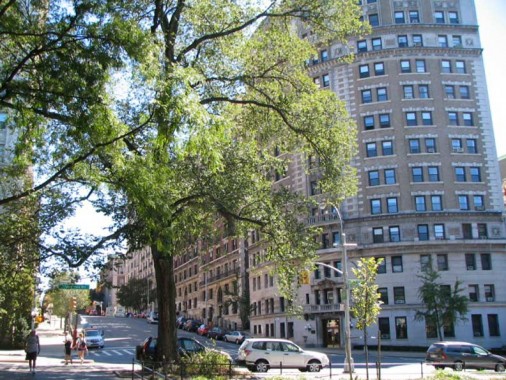

Looking east on Riverside Drive and West 116th Street. Here is New York City’s “original” Colosseum (I realize that Robert Moses’ big, drafty exhibition space at Columbus Circle from the 1950s to the 1990s was spelled “Coliseum”). The gently curving apartment building was constructed in 1910 and, between 1920 and 1925, was home to US Supreme Court Chief Justice Harlan Fiske Stone (1872-1946).
The west end of West 116th Street at Riverside Drive is marked by the Women’s Health Protective Association Fountain, installed in 1909, Bruno Louis Zimm, sculptor. The fountain consists of a stele with a fountain in front, with two marble benches on the side inscribed with the names of WHPA founders and associates. Charlotte Wilbour, whose name can be seen on the bench below right, helped to found the first New York City Woman Suffrage Association in 1870; it was among the first organization to agitate for female voting rights, which finally came to fruition in 1920.
I thought this fountain looked vaguely familiar, and sure enough, sculptor Zimm also created the poignant Slocum Memorial in Tompkins Square Park in the East Village.
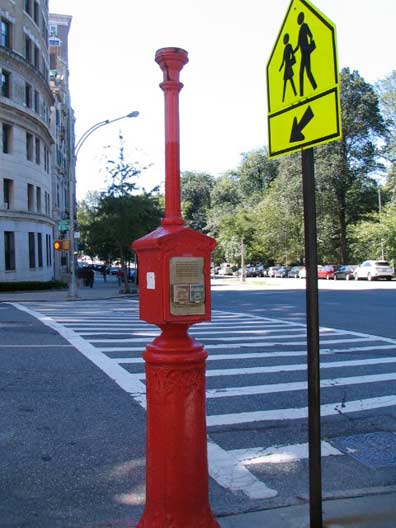
FDNY alarms with lamp fixture attached date to 1912.
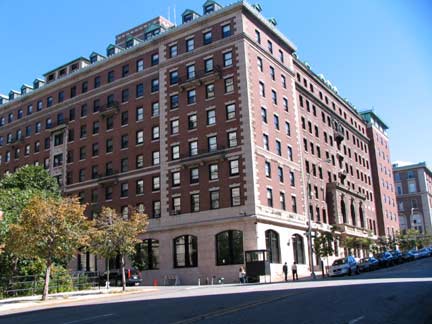
Hewitt Hall, Barnard College. West 116th is basically a one-block street from Riverside Drive to Broadway, with Claremont Avenue issuing north.
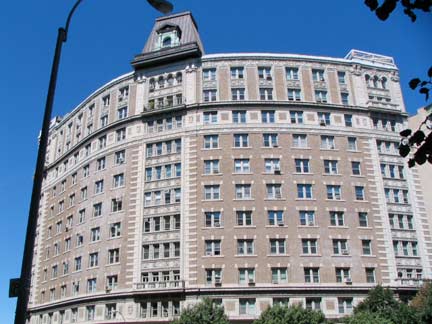
Some grad residential buildings were built to take advantage of the Hudson River view; some are now used as housing for Columbia and Barnard students and faculty.
Columbia
The Columbia University campus runs from West 114th-West 120th Streets between Broadway and Amsterdam Avenue. As Kings College, founded in the colonial era, it once occupied a site near City Hall (a West Broadway building sign still says “College Place”) and later moved to the East River site now occupied by Rockefeller University. It has been here on its magnificent campus with many buildings designed by Charles McKim of the McKim, Mead and White firm since 1897. There was a time when West 116th ran right through the school grounds, but it closed to traffic years ago and is now a grand walkway (College Walk) through the center of the campus. This land was once occupied by the Bloomingdale Insane Asylum (Broadway was called Bloomingdale Road at one time, and these sort of institutions were once located in out-of-the-way parts of town, or even better, islands.) The asylum was in operation from 1821-the mid-1880s. The old Macy Villa (see below) is the only surviving building at Columbia from the asylum era.
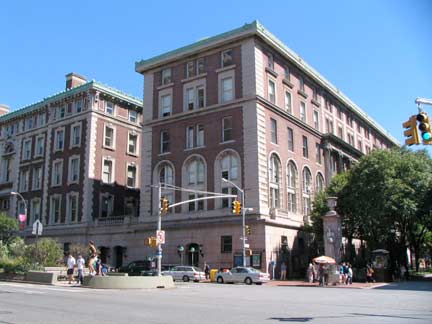
Dodge Hall, containing the Kathryn Bache Miller Theatre, home of Columbia’s music and arts schools, Broadway and West 116th.
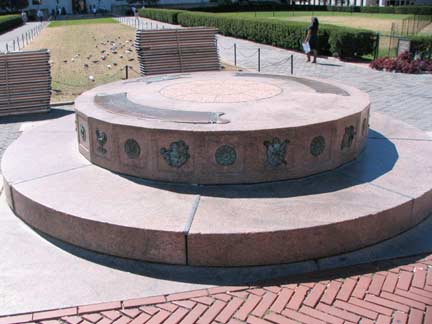
When I did my Columbia slide show, many of the attendees were unaware that the Sundial, a fixture and meeting place on College Walk for over 9 decades, once had a 16-ton polished green granite globe positioned on top of it. It was a gift in 1914 from the Columbia College class of 1885. The sphere began to develop cracks in 1944 and was removed in 1946. For a time Columbia U. did not know its whereabouts, but it turned up in a field in Ann Arbor, MI in 2001; efforts to reclaim it have so far been unsuccessful.
I will touch on Columbia’s great buildings just briefly — they’re hardly Forgotten, after all…

Butler Library has one of the city’s longest Ionic colonnades with 14 pillars. Itis relatively new for classic-styled architecture having been finished in 1934. It was named for Colmbia president Nicholas Murray Butler, who still had 11 years to live after the building was named for him.
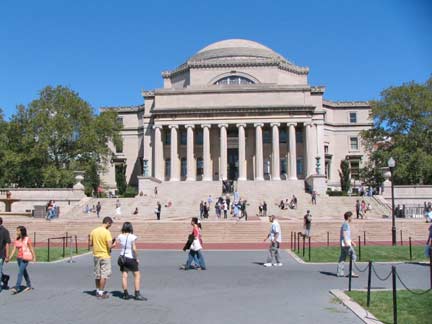
The Low Memorial Library was a charter member of Columbia University, completed 1897 by Charles McKim. It was named for the father of Brooklyn mayor, then Columbia president, then NYC Mayor Seth Low (1850-1916), merchant A. A. Low. It has become a ceremonial space in recent decades. 10 Ionic columns to the Butler’s 14. There was once a rowing track and canvas tank for Columbia’s crew in the basement.
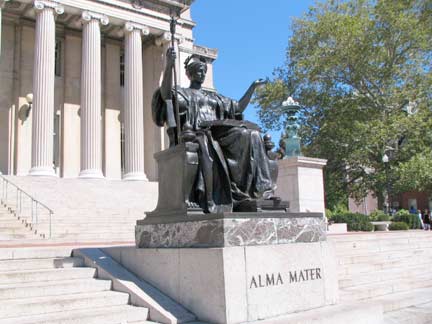
Daniel Chester French’s Alma Mater (1903) greets students, faculty, and mere passersby. Currently bronze-colored, she has been gilded in gold and green with verdigris during the years. Protesters tried exploding her in 1970, but she survived.
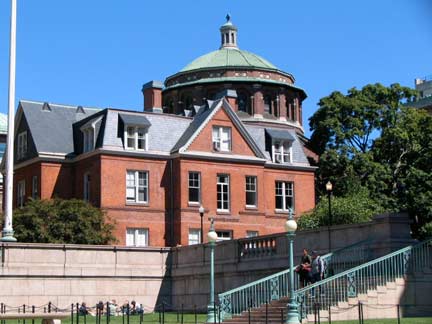
The Macy Villa (foreground) now Maison Française, Columbia University’s center of French culture, is the oldest building on campus and is the only leftover from the asylum days. Officilaly it is known as Buell Hall; when built in 1885, it took its name from principal donor, William H. Macy (not, of course, the red headed actor). And there are some of the lampposts I was talking about.
The Villa adjoins St. Paul’s Chapel, a gift from the Stokes family of industrialists/philanthropists, and completed in 1907. A member of the Stokes family, Isaac Newton Phelps Stokes, was a partner in the firm that built it; Stokes also wrote one of the best NYC histories, the massive The Iconography of Manhattan Island.
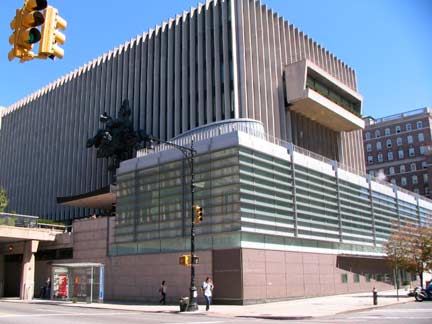
West 116th resumes for just one block between Amsterdam Avenue and Morningside Drive. You can pick your poison here with a couple of modern blandifications; the 1996 Jerome L. Greeene Hall, or the charmless 1961 Columbia Law School it was added to. The Law School is livened up only by the Jacques Lipschitz sculpture Bellerophon Taming Pegasus, from the Greek myth about the flying horse and its jockey.
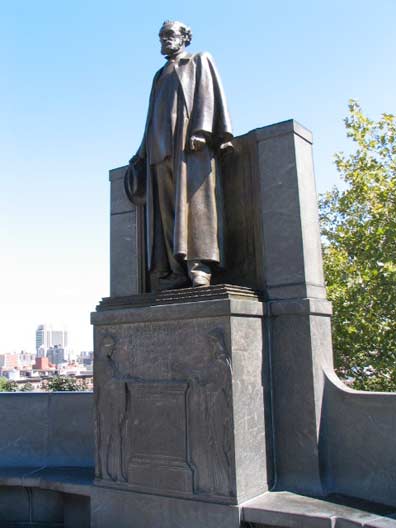
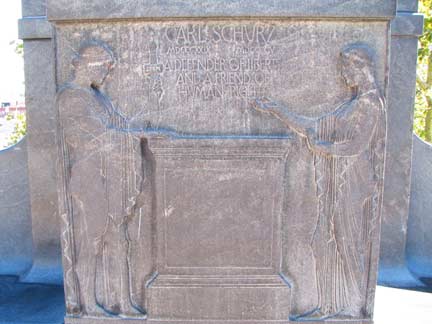
Who is that guy? West 116th comes to a halt once again at Morningside Drive, overlooking Morningside Park. It would have to descend a steep angle indeed if it were to be run through here, so 19th century engineers and surveyors didn’t even try it. This dramatic setting is marked by Karl Bitter/Henry Bacon’s 1913 Carl Schurz monument, honoring the a mid-19th century German immigrant (1829-1906) who became a Civil War general, US Senator from Missouri (1869-1875), Rutherford Hayes’ Secretary of the Interior (1877-81), editor of the New York Tribune and Harper’s Weekly.
I can’t help mixing him up with Charles Schulz, the creator of Peanuts.
True to form, my chief interest in the Schurz Monument rests in the two distinctive lampposts on either side, designed, as many early 20th Century posts were, with a horticultural motif. The “cage” luminaires replaced white glass globes several decades ago. According to some accounts, these are 1930s posts that replaced even more ornate earlier designs.
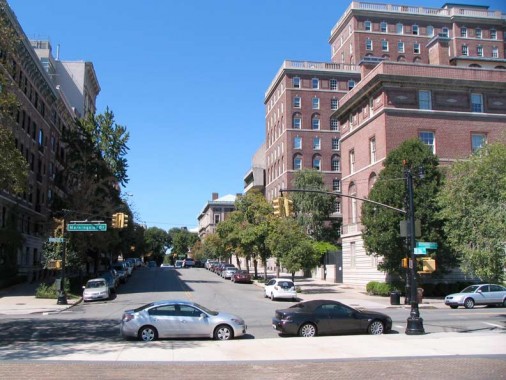
Taking a look back at West 116th before plunging into Morningside Park and Harlem beyond. The modest building on the right is the Columbia U. President’s House, designed by William Kendall of the McKim, Mead and White firm in 1912.
Morningside Park
Early on, developers realized the steep slope in this part of town would be impractical to lay out streets and houses and so, as early as the 1850s, it was thought a better idea to design a public park for the sliver of land from Cathedral Parkway (110th Street) north to West 123rd and generally between what became Morningside Drive and Morningside Avenue. Central Park’s architects Frederick Law Olmsted and Calvert Vaux were brought in to design most of the park. By the 1980s the park had fallen into disrepair and was crime-ridden, before a 1989 redesign. 1998 saw the initiation of the Dr. Thomas Kiel Arboretum, named for the founder of Friends of Morningside Park who was killed in a 1996 accident. The arboretum is located down the steps near West 116th.
That the park is called “Morningside” is easily discernible from its remarkable eastern views. When O & V’s initial design for the walkway and steps overlooking this view were rejected, their Central Park collaborator, Jacob Wrey Mould (who designed the Terrace overlooking Bethesda Fountain, and many of Central Park’s decorative arched roadways) was brought in, and it’s his designs for the monumental buttressed masonry wall and massive steps, with their concrete stanchions and globes, that you see here.
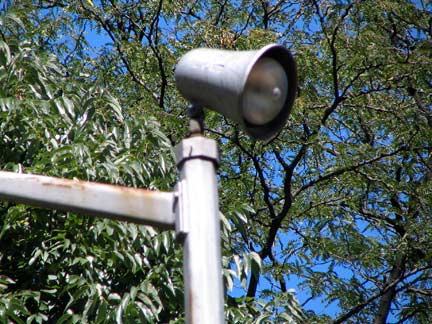
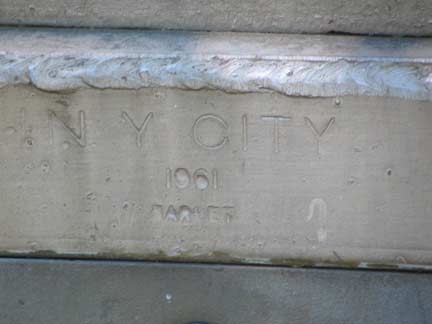
Some of Morningside Park’s walkway posts go back quite a few years. How do I know? Elementary. The date of installation, or at least production, is stamped on the door that opens to the posts electronic controls found on the lamppost base. There was also this antiquated lamp at the apex that illuminates a basketball court or playground, I forget which. These emitted a faint green-white glow and were phased out beginning in the late 1970s.
No more interruptions! (Not your webmaster; I’m always being interrupted when writing FNY pages by various and sundry obligations) No, I mean 116th, which runs continuously from Morningside Avenue all the way east to the Franklin Roosevelt Drive at the Harlem River. Like most of Manhattan’s uptown parks, high-quality (at least when built) residential architecture sprung up on the streets surrounding them. Lower left: the building’s contours bend to match the curve of Morningside Avenue.
Lower right: I applaud the Department of Transportation’s recognition of early NYC lampposts designs: Beginning in the 1980s they cast new molds of classic designs such as the bishop crook and Corvington. This one, however, was never specifically in the classic catalog, but is a new design for walkways that is a hommage, with its decorative ironwork, of earlier designs.
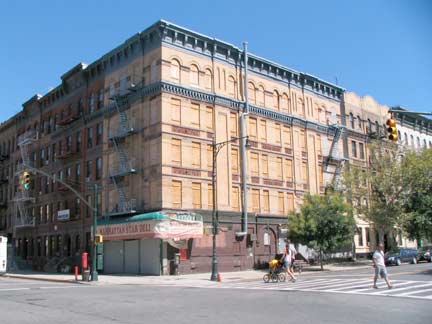

The building at the NE corner of West 116th and Manhattan Avenue is unused at present, and the awning sign on the corner has slipped, revealing a green and gold raised-letter sign beneath. These type of vinyl signs were sponsored by Coca-Cola and you will generally find a Coca-Cola ad included on them.
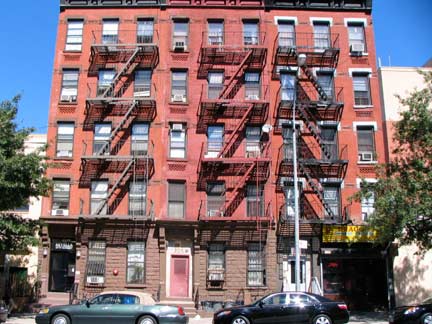
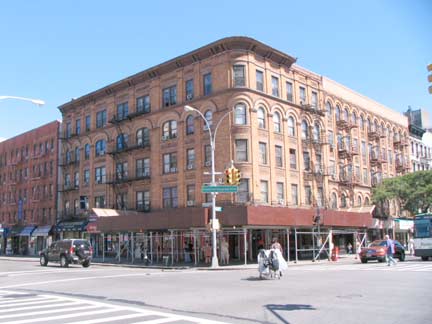
What I call the casual magnificence of pre-World War II residential architecture is exemplified all over Harlem. Here are some examples at 305 West 116th and above left, the gentle curve of the NE corner building at Frederick Douglass Boulevatd (8th Avenue) and 116th.
Note to Harlem residents: do you call Douglass Boulevard that, or The Fred, or just plain 8th Avenue? Seems like a long moniker to casually spit out, over and over.

I like Douglass Blvd. north of Central Park — it’s a stronghold of double-masted octagonal-shaft poles, as seen in photo left.
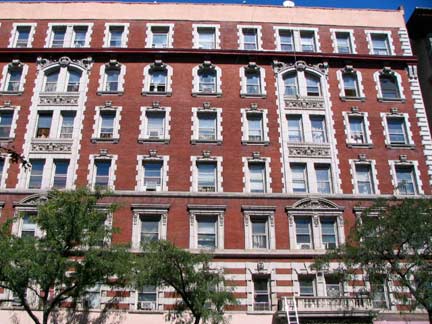
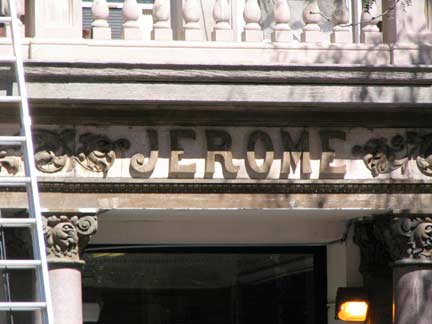
The Jerome, between Douglass and Powell Boulevards. I wonder if Bronx racetrack pioneer and grandfather of Winston Churchill had anything to do with this building.
First Corinthian Baptist Church, SE corner of Adam Clayton Powell Boulevard and West 116th, is a shadow of a fantastic past as its old incarnation, as the Regent Theatre. Its terra cotta exterior is still in evidence, though. Thomas W. Lamb, the prolific theatre architect, built it from 1912-1913, based, it is attested, on Venice’s Doge’s Palace.
Despite its opulence, the Regent Theatre was an almost instant disaster, causing owner Henry Marvin to summon up-and-coming impresario S.L. Rothafel to the rescue. ‘Roxy’s’ innovative taste and showmanship had already helped to save unsuccessful theatres in other parts of the USA, but this was his first chance to prove himself in the “big time.” He closed the Regent Theatre for several months while he changed some of the interior furnishings, installed potted plants, new stage lighting and curtains, and hired a symphony-sized orchestra to play music that was specially arranged to match the movies. When the Regent Theatre re-opened in December with “The Last Days of Pompeii”, the ‘Roxy’-produced programs became the talk of New York, and soon earned him a better offer to take over the direction of the Strand Theatre on Broadway in the midtown theatre district.
But the Regent Theatre continued to flourish and benefited from a take-over by B.S. Moss, who added Keith-Albee vaudeville to support the movies. Due to that connection, the theatre eventually became the RKO Regent, and went through some minor “modernizations” in 1939 and 1944.
The RKO Regent Theatre closed as a movie house in 1963, but was still listed in the 1964 edition of Film Daily Year Book. The Regent Theatre was taken over by an evangelical church, and remains one to this day. Cinematreasures
St. Nicholas Avenue is one of northern Manhattan’s oldest roads, and in places cuts diagonally athwart the street grid. It intersects Adam Clayton Powell Boulevard (7th Avenue) and West 116th, forming A. Philip Randolph Square, named for the prominent 20th Century civil rights leader (1889-1979). “Abyssinia” is an old name for Ethiopia, the land occupying the horn of Africa; the Abyssinian Baptist Church has been in Harlem since 1808, founded by Ethiopian-American merchants. I was reminded of author/playwright Dalton Trumbo by the name on the funeral home, and sought a connection there, but Trumbo was from Colorado.
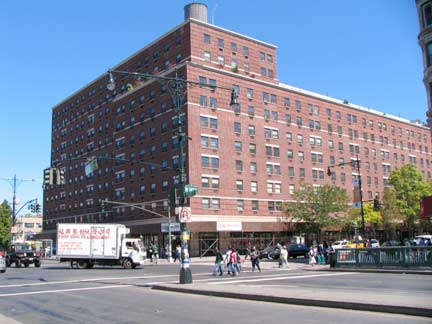
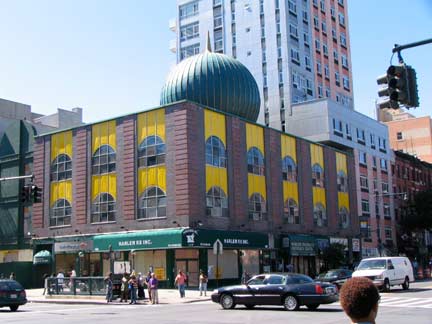
The avenue that falls between 5th Avenue and Adam Clayton Powell Boulevard above Central Park has had three names during its long history, and all three names have contained an “x”: Sixth Avenue, when laid out as part of the Mangin street plan of 1807; in 1887, renamed Lenox Avenue for the Lenox family who established a library now part of the NYPL; and in 1987, Lenox was given a co-title, Malcolm X Boulevard, for the civil rights leader slain in Harlem in 1965.
The avenue features some grand apartment buildings and has become a bastion of twin Corvington long-armed lampposts. On the southwest corner is the Malcolm Shabazz Mosque No. 7, Sabbath Brown, architect 1965, the year of Malcolm X’ death: he was a preacher at the mosque’s original building. It replaced the old Lenox Casino.
Malcolm X Boulevard features lampposts and stoplight stanchions found nowhere else in the city. The “don’t walk” sign posts are based on the Type B park posts, while there are small “mini-me” Corvington type standalone lamps, as well as masts attached to full size posts. In addition, in some spots Malcolm X Blvd has been given its own unique street sign designs.
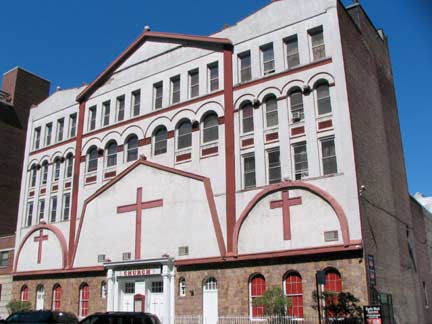
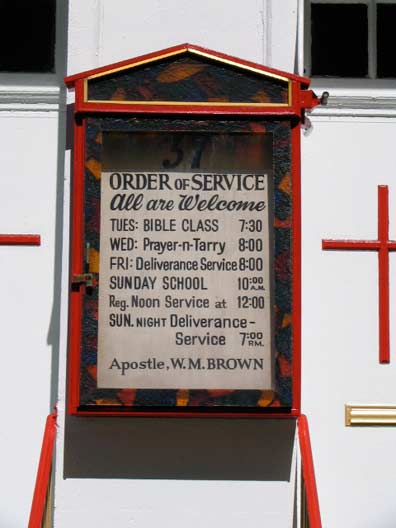
The massive Salvation & Deliverance Church, north side of West 116th between Malcolm X Blvd. and 5th Avenue. Like many of NYC’s older churches it has a quaint signboard with hand lettering.
ForgottenFan Benjamin Waldman, quoting a 6/7/2002 NYTimes article: at No. 37 is the Salvation and Deliverance Church. This was once Rabbi Herbert S. Goldstein’s Institutional Synagogue, which drew new generations to Orthodoxy by offering social, educational and recreational services, inspiring a phenomenon known as the ”shul with the pool.” Goldstein held huge youth rallies in a nearby theater.”
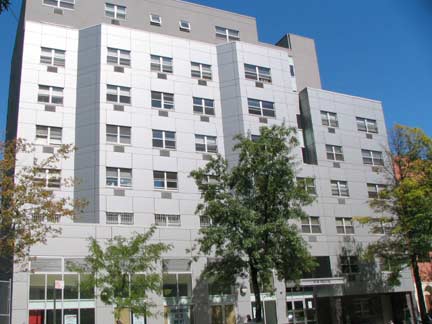
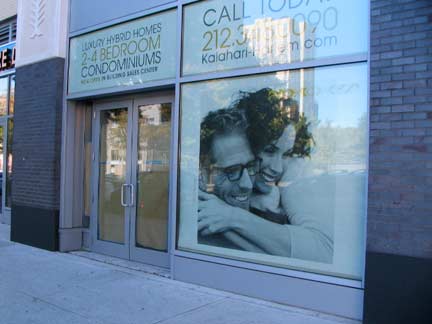
Some architecture critics I have read lately have carped that it’s hard to build in NYC partly because out-of-context developments are so frowned on. 40 West 116th, the Kalahari Condominiums, named for the desert in southern Africa, try to break the contextual rule. I think they’re using the wrong photo in the sales window — in an overwhelmingly minority neighborhood attempting to remain affordable, I just think it sends the wrong message, but that’s how my thought processes go.
The Queen of Avenues. Above Duke Ellington/Frawley Circle at 110th Street, 5th Avenue is something of step down from what it was from Washington Square Park north past Central Park. Looking south, though, if you jump in a cab and head south, in a few miles you will arrive at the King of All Buildings.
On the northwest corner of Madison Avenue and East 116th Street is a magnificent ruin. The Doric-columned former Public National Bank has left its imprint. Not much is known about the bank except that it was formed in 1908 and merged in 1955 to form the State Bankers Trust Co. Amazingly, the bank’s name is still visible. The space looks as if it has been empty since the 1940s.
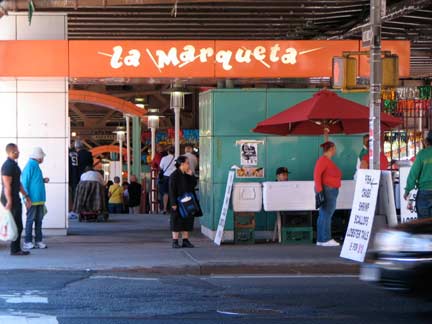
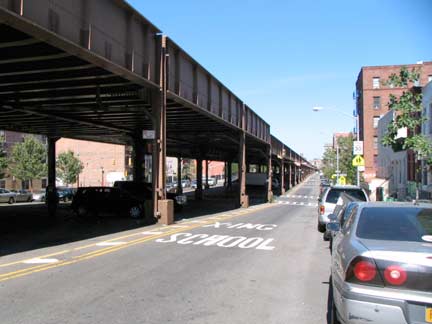
Metro North (former NY Central) tracks run above Park Avenue, making it also quite changed from the magnificent divided boulevard it is below 97th Street. Under the elevated tracks on East 116th is La Marqueta, which occupies the space under the tracks from 111th north to 116th; the market is in its 8th decade and was formed after Fiorello LaGuardia outlawed pushcarts as they began to impede mechanized auto traffic.
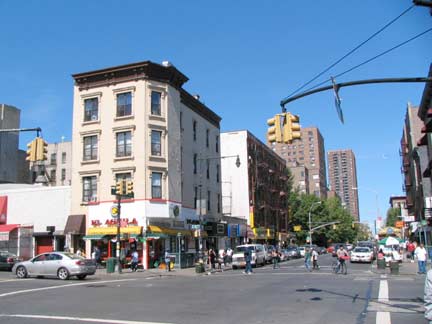
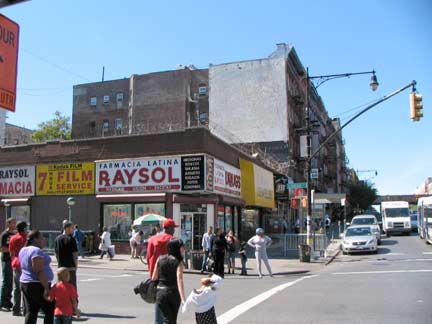
Lexington Avenue and East 116th is the main shopping mecca of Spanish Harlem, although it now has steep competition from the new East River Plaza, which opened at the FDR Drive and 116th in the summer of 2010.
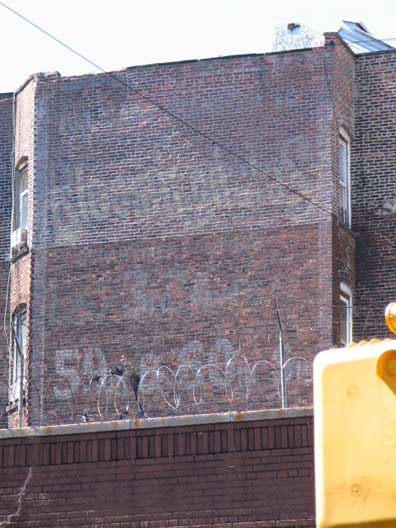
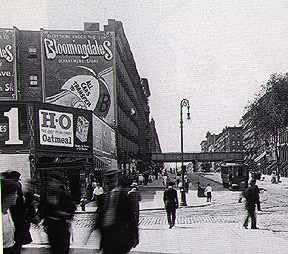
Lexington Avenue and East 116th is the main shopping mecca of Spanish Harlem, although it now has steep competition from the new East River Plaza, which opened at the FDR Drive and 116th in the summer of 2010. A curio from the turn of the 20th Century can be spotted on the apartment building facing Lex on the south side: a surviving Bloomingdale’s painted ad advertising its location at 3rd Avenue and 59th Street — making the ad still good. The ad is cut off on the left side of the photo from 1916.
New York Then and Now, © 1976 Dover Publications


East of Lex, 116th becomes less frenetic and more residential. Years ago, before Spanish Harlem, this part of town had large pockets of German and Italian immigrant populations, and in the streets east of about 2nd Avenue, the Italians are hanging in there to some degree. One of the more important hangers on from the Italian era is Rao’s, the Italian restaurant/celebrity/mob hangout on Pleasant Avenue and East 114th. Another is Morrone’s Bakery. Only the facade remains, though, since it closed in 2007.
Another holdout from the Italian Harlem days is Claudio’s Barbershop, south side of 116th, just west of 1st Avenue. I expressed my regrets at not having time for a haircut to Claudio, who graciously allowed me to come in and take photos anyway. He said this was his 80th birthday and he had been in business 50 years. Films such as Carlito’s Way and TV shows Law and Order and Third Watch have used the shop for local color, and models in bikinis have posed in the barber chairs for Sports Illustrated shoots. Jimmy Durante and Tammany Hall pol Carmine DeSapio have had their locks chopped here, as well as a number of mob figures. And now, FNY has been here, too.
Photographed August 2010; page completed January 16, 2011

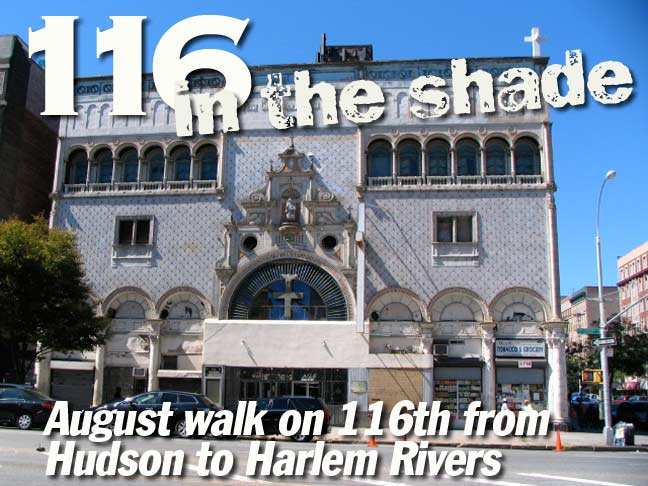
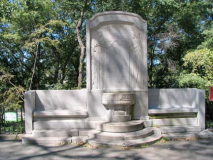
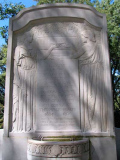
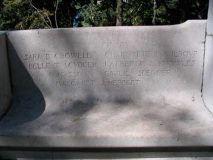

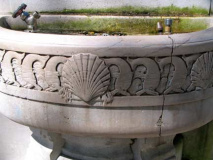
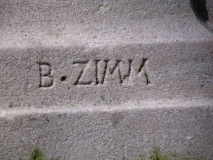
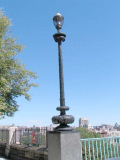
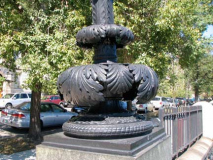
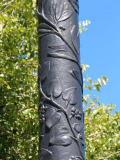
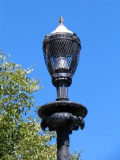
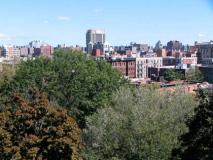
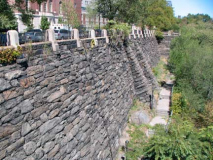
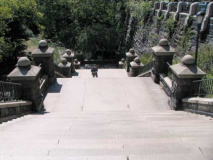
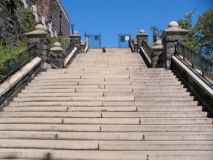
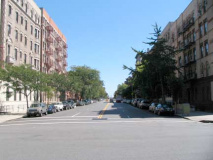
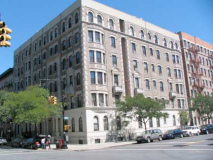
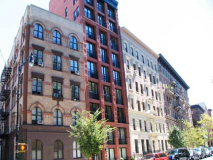
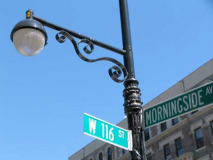
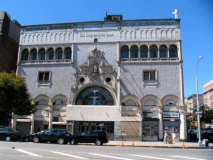
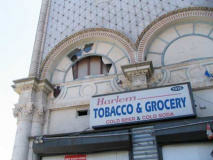
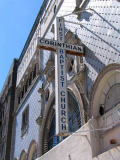
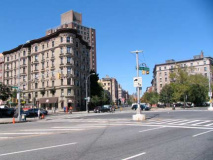
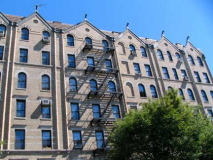
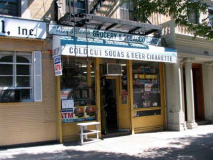
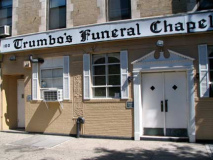
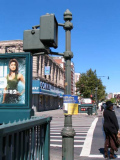
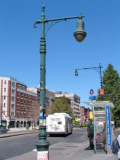

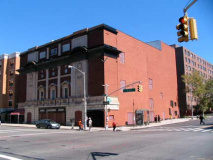
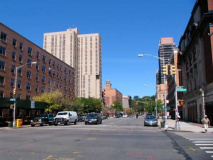
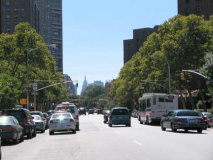

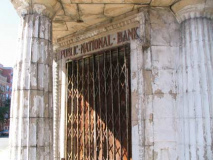
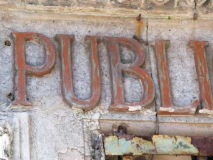
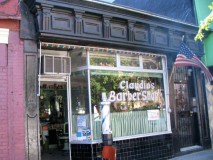
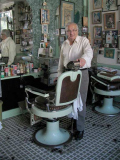
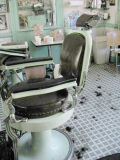
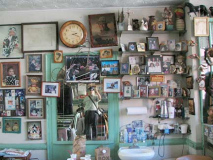
14 comments
Carl Schurz was actually portrayed by Edward G. Robinson in John Ford’s Cheyanne (sp.) Autumn..sorry about the spelling !!! LOVE Forgotten NY !!!! Grandmother grew up on 124 thStreet by Mt. Morris Park- 1904 !!!!
I LOVE HARLEM. WAS BORN AND RAISED THERE. 135 ST. BECAME ADDICTED TO HERON THERE WAS A 116 STREET DOPE FIEND FOR 22 YEARS NOW IM CLEAN FOR 23 YEARS WHAT A RIDE I MIS THAT GRAND OLD LADY SO
Hi, CNOTE and all here,
Congratulations on your long triumph, CNOTE! I know the feeling with alcohol and other demonic forces! You are right to claim your bragging rights, as I think I am!
I lived in St. Anthony Hall on Riverside Drive off 116th Street when I was 7 with my father and mother, Russell and Olga Lee. who were the famous cooks for that fraternity house back in 1965! My mother once told me how the fraternity members raved about a roast beef she made there! She was a fabulous cook and passed it on to me, as well as extremely good dietary habits. I’m trying to launch a delicious healthful line of super foods/iced teas including quinoa pasta, moringa, and chia, the two latter being some of the most nutrient dense foods in the plant kingdom!
Finally, see my church by Googling, “Free Church of the Divine Marriage.” I’d love to hear from you about it. And once again my most hearty congratulations to CNOTE on having gone to hell and back!
Hi!
Thank you for bringing back memories by choosing the RKO Regent Theatre, among all the beautiful historical landmarks located in Harlem. During the late 60’s I attended the First Corinthian Baptist Church under the leadership of Rev. Thomas H. McKinzie, Sr. However, this was during my informative years I was quite young. On the other hand, it was truly enjoyable being there not only did I get to listen to an uplifting sermon, I also had been blessed to hear my mother play the organ every Sunday. Thanks again!
Does anyone have any information regarding a photo studio that used to be at 12 East 116th Street? I think it was called R. Castilla.
I would like to know if where could negatives of photos taken be after the business closed. I have a photo of my Mom and it has the studio’s name and address on it.
I thought it was Castillo. Not sure where the owner moved to. My Mom also had pics from there. 1950’s.
I just happen to be looking for similar information! I found the studio name and address on the I size cover of my parents’ wedding album.
I found images of my Grandparents from that Studio. Rumor has it, that my Grandmother’s picture was in the window and my Grandfather inquired about her because he thought to himself this beautiful woman could be my wife. He was right! ❤️
Hi,
My father took his wedding picture at that studio in the late 1940’s;
I recently looked at the photo and noticed the studio’s name.
It seemed to be a popular place back then. Any further information about
that photo studio and/or its owner would be a great help.
-Trying to get historical information about my father’s life to create
a story board, to pass on to family members. Thank you!
Thank you so much for these old memories. I actually forgot some of this stuff.
231 East 116th Street was the residence of Congressman Vito Marcantonio. Known to all as Marc, he was a protege of Fiorello La Guardia and was very
controversial. Thought by many to have Communist leanings, he cast the sole vote in Congress against American participation in Korea and was
denied a Catholic burial by Cardinal Spellman.
Going back a tad to 1880. As mentioned this had a then largely German American population residing in Morningside, including my immigrant great-grandfather and family. He is reported via census and address listings as having been employed in the “lager beer business”. He vouched for his son in law Henry in 1885 who gave my GG’s name as a reference claiming he could be contacted at a corner “saloon” at West 116th Street and 8th Avenue. This location is verified on several documents. I am wondering if it was at the site of Hewitt Hall you picture above?
(He had his funeral at St. Pauls German Evangelical Lutheran Church at West 123rd St. in 1915)
Do you have any idea if or how I might discern any record of this tavern or am I headed on a wild goose chase? As the period of
time documented spans at least two decades 1880-1900 I would love to find information. Any suggestions? Your site, as always
is wonderful!
PS I also did not go to Columbia – when I was (not thaat long ago) of college age and going to school in Manhattan, Columbia did
not accept women. I find it ironic since my ancestry was instrumental in helping develop that area; they were largely
carpenters, plumbers and contractors firmly entrenched in America’s working class. One family project was Riverside’s
The Chatsworth.
Nah. None of that is forgotten. What is forgotten was the Dutch families that lived there. Like my 6th Great grandfather on the corner of W116th and16th avenue(renamed possibly to Broadway).
Whatever happened to the Delightful Coffee Shop on 116th St and 2nd Ave? Or the little sandwich shop on 2nd Ave downtown side where the 102 or 101 bus stopped? this was in the 70’s and the 80’s.